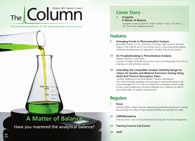Detecting Off-Target Bromethalin Poisoning
Researchers from the California Animal Health and Food Safety Laboratory at the University of California Davis in the USA have developed an ultrahigh-performance liquid chromatography–mass spectrometry (UHPLC–MS) method for the detection of desmethylbromethalin (DMB) residues in animal tissues.

Photo Credit: Niccirf/Getty Images
Researchers from the California Animal Health and Food Safety Laboratory at the University of California Davis in the USA have developed an ultrahigh-performance liquid chromatography–mass spectrometry (UHPLC–MS) method for the detection of desmethylbromethalin (DMB) residues in animal tissues.1 DMB is the toxic metabolite of bromethalin, a neurotoxic rodenticide that has increased in usage because of new regulations introduced by the U.S. Environmental Protection Agency (EPA) to phase out the use of other “second-generation” or long-acting anticoagulents in rodenticides intended for use in residential areas, leading consumers to look for alternatives.
The U.S. EPA introduced regulations in 2008 to phase out the use of anticoagulents in rodent poisons because of risks to children, pets, and wildlife. However, lead author Michael S. Filigenzi told The Column that consumers have now increased their use of an alternative chemical, bromethalin, increasing the danger of poisoning non-target animals. Toxicologists therefore needed a method to detect bromethalin in brain, liver, and fat tissue to confirm bromethalin exposure in animals post-mortem.
The team initially developed the UHPLC–MS–MS method with electrospray ionization using a bromethalin standard, but found the primary ion signal was not as expected. Filigenzi told The Column: “The results were consistent on different instrumentation and over time, so we developed HPLC conditions and an extraction method which appeared to give us a reasonable detection limit (in the low to mid part per billion range) and we detected it in a tissue sample from an animal suspected to have been exposed to bromethalin.” He added: “We felt that we had a useful method but our inability to determine exactly what we were detecting was worrisome, to say the least. Then, a desmethylbromethalin standard became commercially available. When we analyzed that standard, it became evident that the compound we had been detecting all along was actually the desmethylbromethalin - we weren’t detecting bromethalin at all.”
Simultaneous analysis by HPLC with UV and MS of the bromethalin standard detected a low level impurity of desmethylbromethalin (<1%), which Filigenzi attributes to the poor ionization of bromethalin by electrospray LC–MS; DMB ionizes exceedingly well. Feligenzi concluded: “Fortunately, bromethalin is metabolized to desmethylbromethalin, which is the toxic form of the compound and which will be present in animals exposed to bromethalin. This makes it a good indicator of exposure. The published method detects less than 1 ppb of desmethylbromethalin in tissue samples, which has proven to be sufficient to demonstrate exposure to the rodenticide in a number of cases.” - B.D.
Reference
1. M.S. Filingenzi, A.C. Bautista, L.S. Aston, and R.H. Poppenga, Journal of Agricultral and Food Chemistry DOI: 10.1021/jf5052706 (2015).

New Method Explored for the Detection of CECs in Crops Irrigated with Contaminated Water
April 30th 2025This new study presents a validated QuEChERS–LC-MS/MS method for detecting eight persistent, mobile, and toxic substances in escarole, tomatoes, and tomato leaves irrigated with contaminated water.
Accelerating Monoclonal Antibody Quality Control: The Role of LC–MS in Upstream Bioprocessing
This study highlights the promising potential of LC–MS as a powerful tool for mAb quality control within the context of upstream processing.
University of Tasmania Researchers Explore Haloacetic Acid Determiniation in Water with capLC–MS
April 29th 2025Haloacetic acid detection has become important when analyzing drinking and swimming pool water. University of Tasmania researchers have begun applying capillary liquid chromatography as a means of detecting these substances.

.png&w=3840&q=75)

.png&w=3840&q=75)



.png&w=3840&q=75)



.png&w=3840&q=75)










